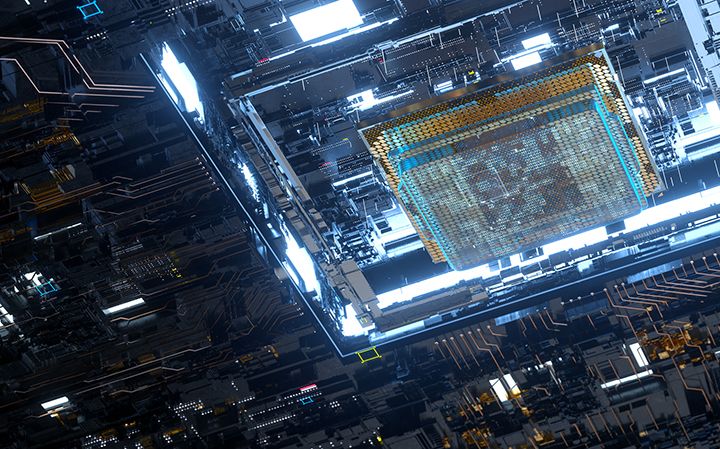
Applying intelligent automation to solve key agency challenges
These loaded questions guide our public sector digital transformation work—and the answer is different for every agency due to the distinct mission objectives and organizational contexts at play. But while each agency context is unique, there are a set of architectural problems that we commonly see across agencies that intelligent automation (also known as hyperautomation) can help solve.
An intelligent automation solution
Here is a simple illustration of the tools and technologies that comprise an intelligent automation solution:
Deciding how to combine these technologies to achieve mission success is equal parts art and science. When orchestrated effectively, an intelligent automation solution can transform service delivery, solve data issues, introduce process flexibility, and preserve institutional knowledge. Let’s take a closer look at these four common agency architectural challenges through a solutions lens.
Inconsistent service delivery
In 2020, citizen satisfaction with federal government services fell for the third year in a row, dropping 4.4% to 65.1% overall, according to the American Customer Satisfaction Index. Why the downward trend? Much of the problem stems from legacy systems that were designed without current citizen needs in mind—and that lack the flexibility to adapt to the needs of the day.
Take a contact center, for example. As noted in the Digital.gov guidelines, today’s digital citizens want to speak to government agencies via multiple channels—web, social media, mobile technologies, and phone—but many contact center systems were designed primarily for phone intake and fall short of the omnichannel support that citizens expect. To improve service delivery across all channels, agencies need to design information flows and knowledge resources that match common customer journeys, a process that leverages human-centered design principles and results in a more empathetic and effective contact center experience.
From a systems perspective, agencies will need to reimagine their front-end digital experience and orchestrate the systems and dataflow in the back-end to activate artificial intelligence and machine learning capabilities. The conversational AI elements of intelligent automation (which can include chatbots, smart speakers, and virtual assistants) help agencies deliver a consistent service experience across channels.
Data access, fragmentation, and volume issues
Data issues also abound in the federal government. Agencies currently collect more data than they know what to do with thanks to the proliferation of tracking scripts, sensors, markers, and devices that power our modern lives. Discrepancies in the quality of that data are a serious problem for federal agencies ill-equipped to manage, catalog, and sift through the incoming flood of raw information. And unfortunately, the legacy systems through which the data is supposed to flow are too outdated, slow, clunky, and siloed to properly manage its collection in an easily-indexable or communicable way from an IT perspective.
The intelligence layer of an intelligent automation solution—which includes the predictive analytics and machine learning elements—addresses data quality challenges by pulling speech, image, video, and unstructured text into a single repository. From here, AI and machine learning can be applied to the data to deliver predictive analytics scoring and services to the application layer. As its name implies, the intelligence layer uses data to help the process continually learn and improve.
Rigid business rules that are hard to monitor and change
It’s a challenge to optimize and improve when the business rules that fuel your processes are outdated and hard-coded into the system. Many agencies face this problem due to legacy applications that were custom-built for the program as it was in the past. As technology and customer expectations evolve, as they always do, these rigid business rules begin to hinder progress and can have a negative impact on the mission.
With the introduction of low/no-code platforms, business and domain leaders can own their own destiny when it comes to business processes. These flexible platforms power process automation and allow agencies to compose and execute business processes across the organization—and change them as needed to optimize performance.
Skills turnover that inhibits key systems maintenance
One of the biggest pain points we see across agencies is the inability to maintain systems that contain key insights due to skills turnover. The knowledge is trapped in legacy systems, and in the minds of a retiring workforce. And the talent is not plentiful and available enough to evolve, maintain, and modernize that knowledge.
Robotic process automation (RPA)—the automation of labor-intensive, repetitive tasks across multiple systems and presentation layers—is especially helpful at solving this challenge. RPA uses physical or virtual robots to support human-led functions and introduce efficiencies without the need for reengineering. It can be plugged in to support the places in the IT ecosystem where (1) the knowledge has dried up or retired; and (2) the costs of system replacement are prohibitive. RPA automates essential tasks run on legacy systems while allowing program leaders to focus rebuilding and replacement efforts in the right places.
Smarter, faster, better.
Successful modernization hinges on knowing which tools and technologies to plug in to improve mission outcomes. It’s the opposite of tech for tech’s sake: An effective intelligent automation solution requires a firm foundation of domain expertise, and is the result of close collaboration between business and IT leaders. Done right, intelligent automation can introduce efficiencies and transform your operations—helping you deliver smarter, faster, and better services.
To hear more from Kyle on how intelligent automation can transform your business processes and help you meet your mission, read his latest paper: Smarter, faster, better: Intelligent automation at work in the government.
